Using Remote Sensing to Identify Changes in Land Use and Sources of Fecal Bacteria to Support a Watershed Transport Model
Abstract
:1. Introduction
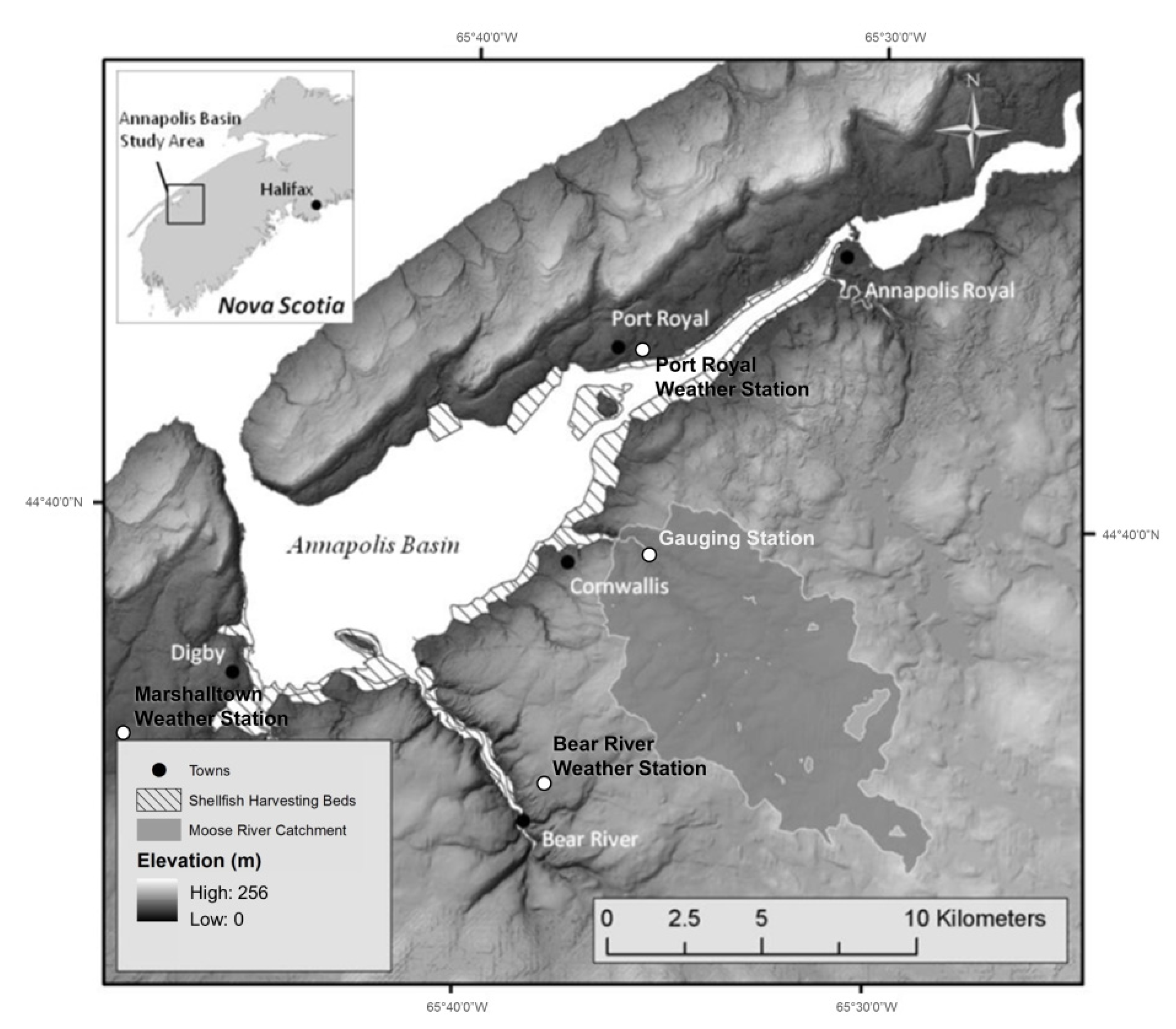
2. Materials and Methods
2.1. Study Area
2.2. MIKE 11 Model Description
2.3. Data Collection
2.3.1. River Stage and Discharge
2.3.2. Weather
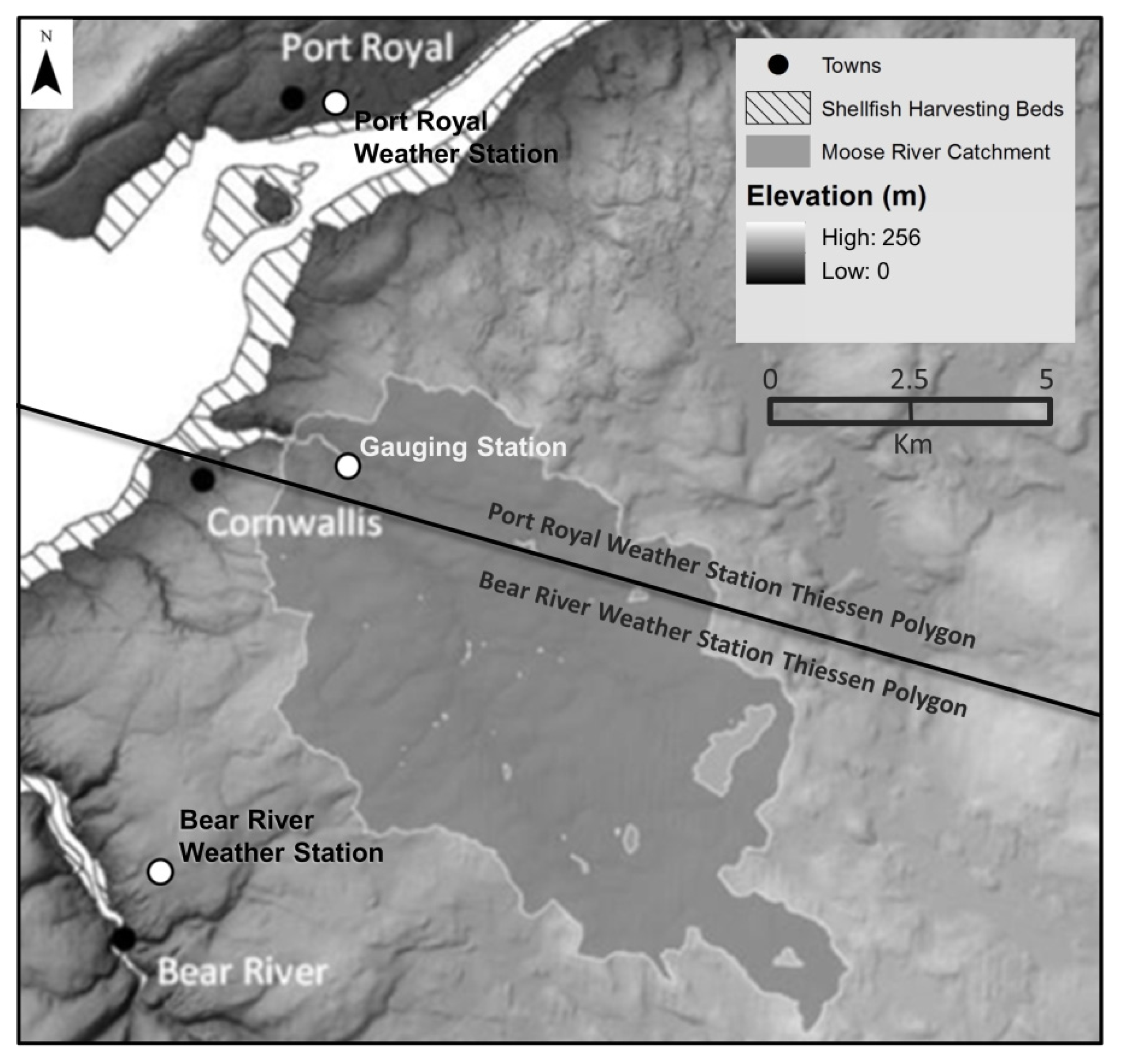
2.3.3. Water Sampling and Lab Analyses
2.4. Model Requirements
2.4.1. Rainfall Runoff (NAM) Module
2.4.2. Hydrodynamic Module
2.4.3. Load Calculator and Advection Dispersion (AD) Module
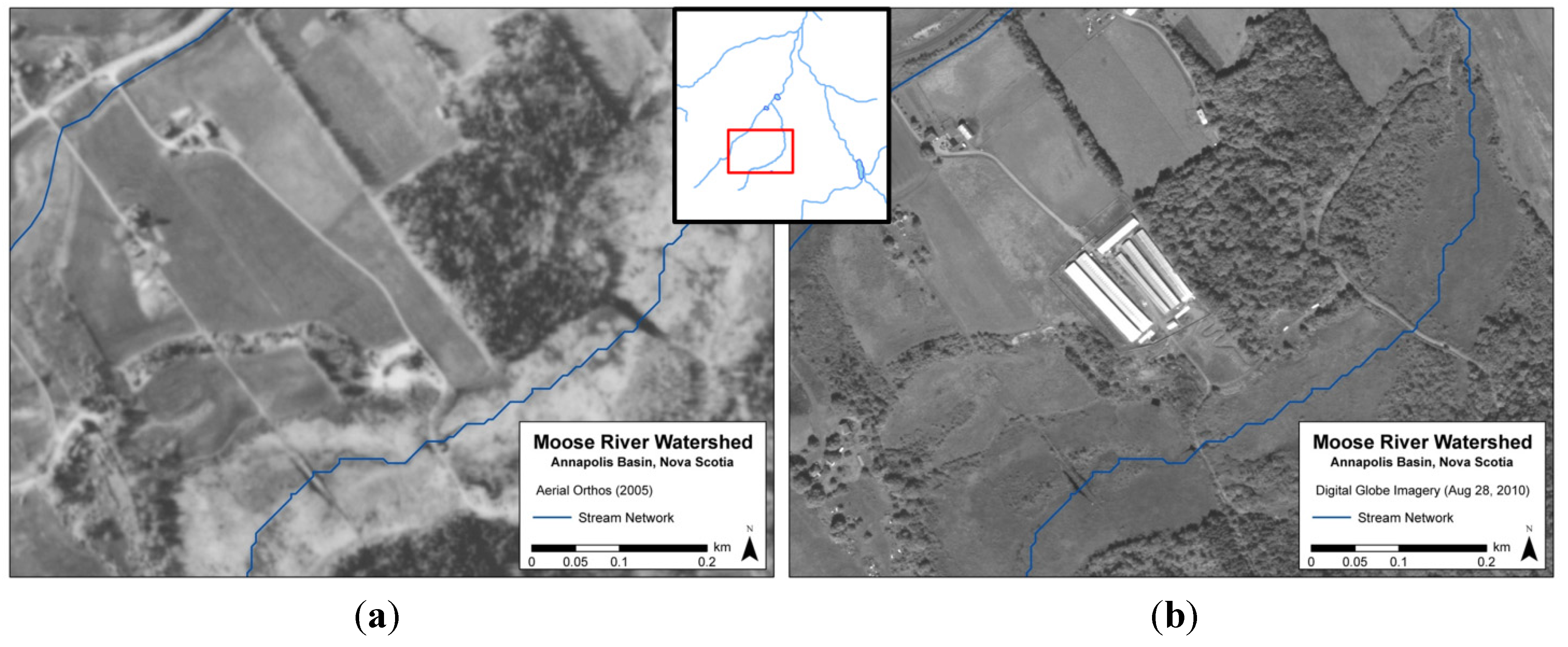
- L = Per capita loading rate (MPN person−1∙day−1);
- RF = Failure rate (%);
- Q = Per capita wastewater discharge (dL day−1);
- C = Wastewater E. coli concentration (MPN∙dL−1).
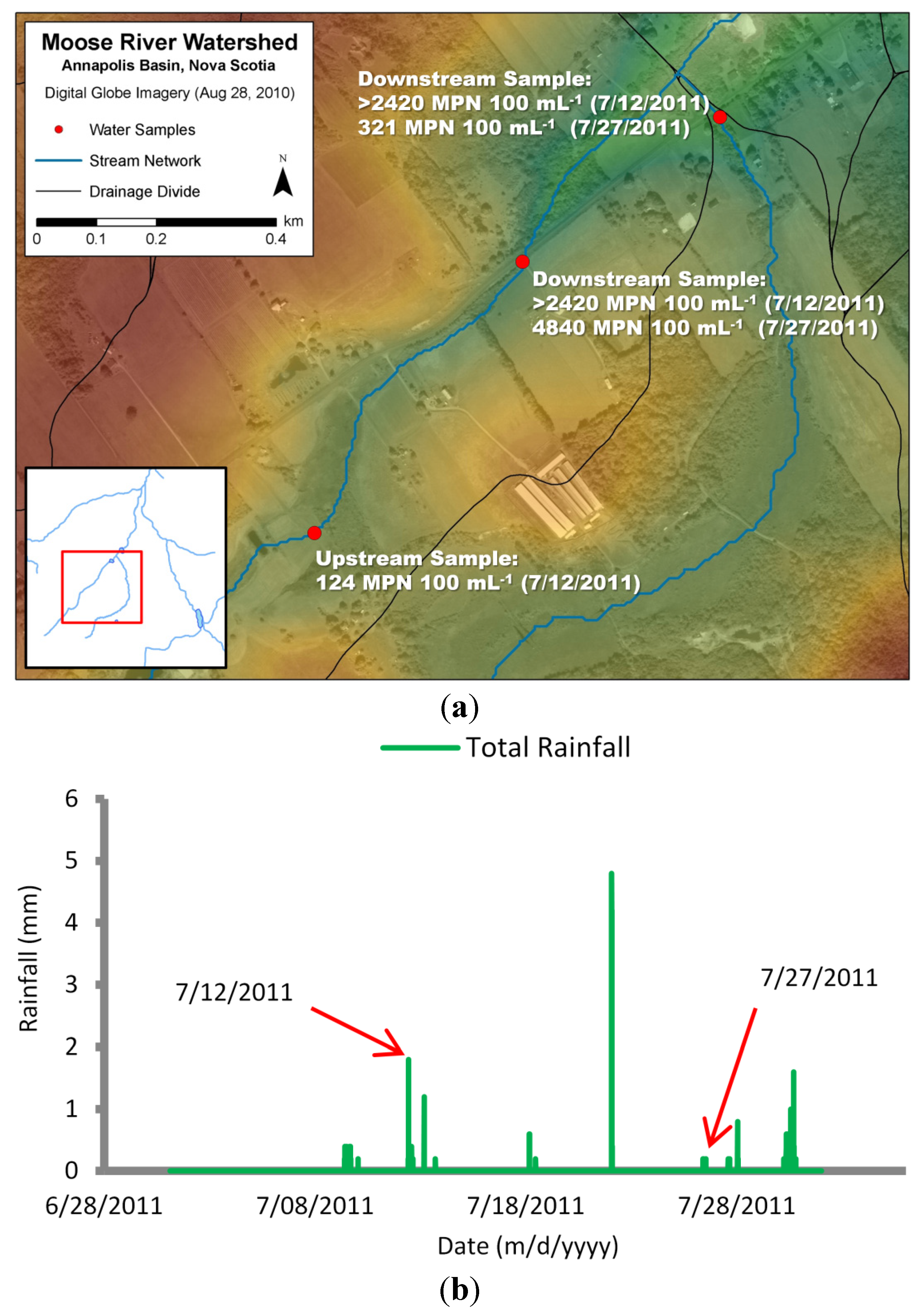
3. Results and Discussion
3.1. Rainfall Module
| Parameter | Description | Parameter value |
|---|---|---|
| Umax | Maximum water content in surface storage (mm) | 13.0 |
| Lmax | Maximum water content in root zone storage (mm) | 100.0 |
| CQOF | Overland flow runoff coefficient (0–1) | 0.41 |
| CKIF | Time constant for routing interflow (hours) | 650 |
| CK1,2 | Time constant for routing overland flow (hours) | 12 |
| TOF | Root zone threshold value for overland flow (0–1) | 0.1 |
| TIF | Root zone threshold value for interflow (0–1) | 0.1 |
| TG | Root zone threshold value for groundwater recharge (0–1) | 0.1 |
| CKBF | Time constant for routing baseflow (hours) | 1000 |
3.2. Hydrodynamic Module
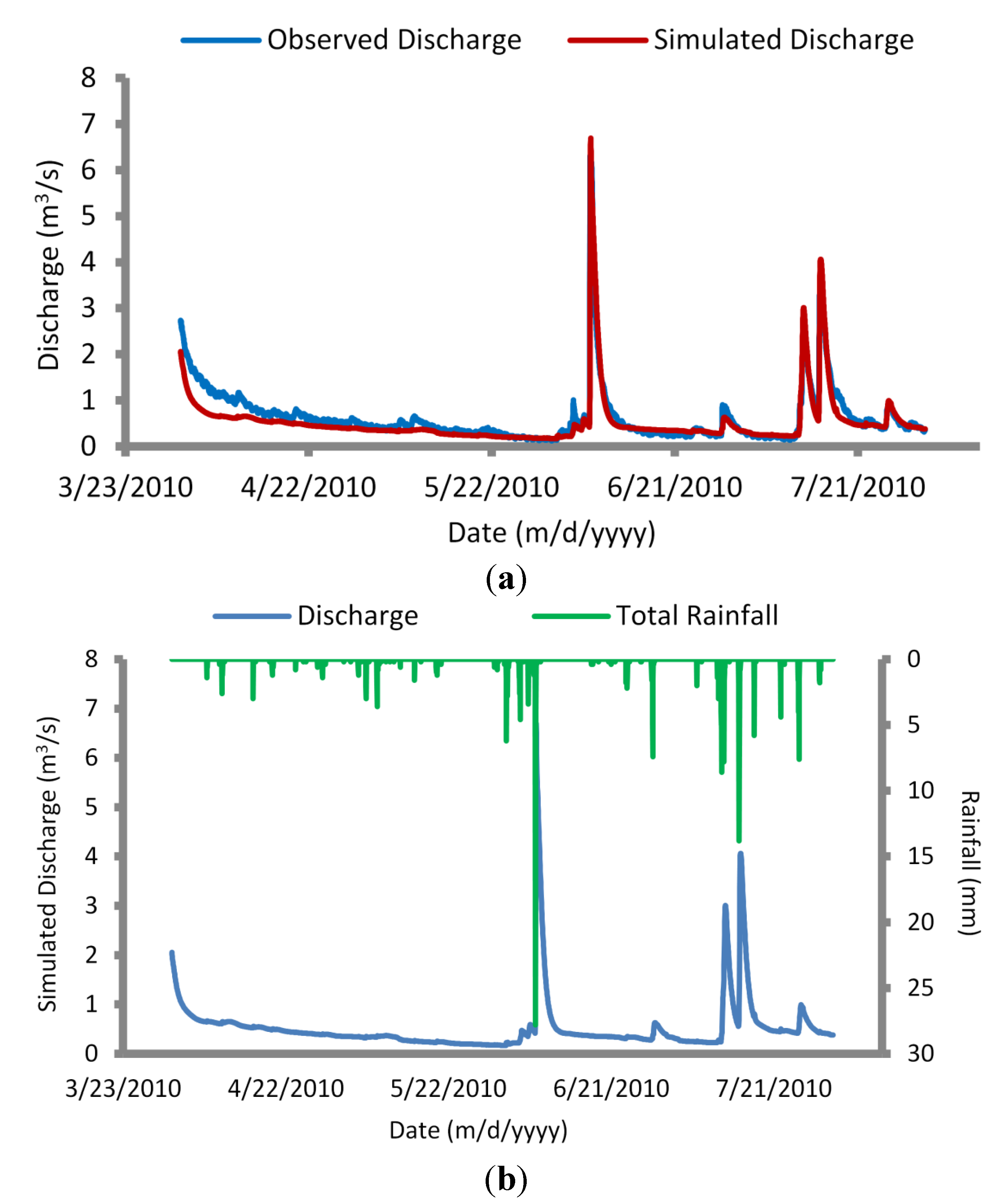
3.3. Load Calculator and Advection Dispersion Module
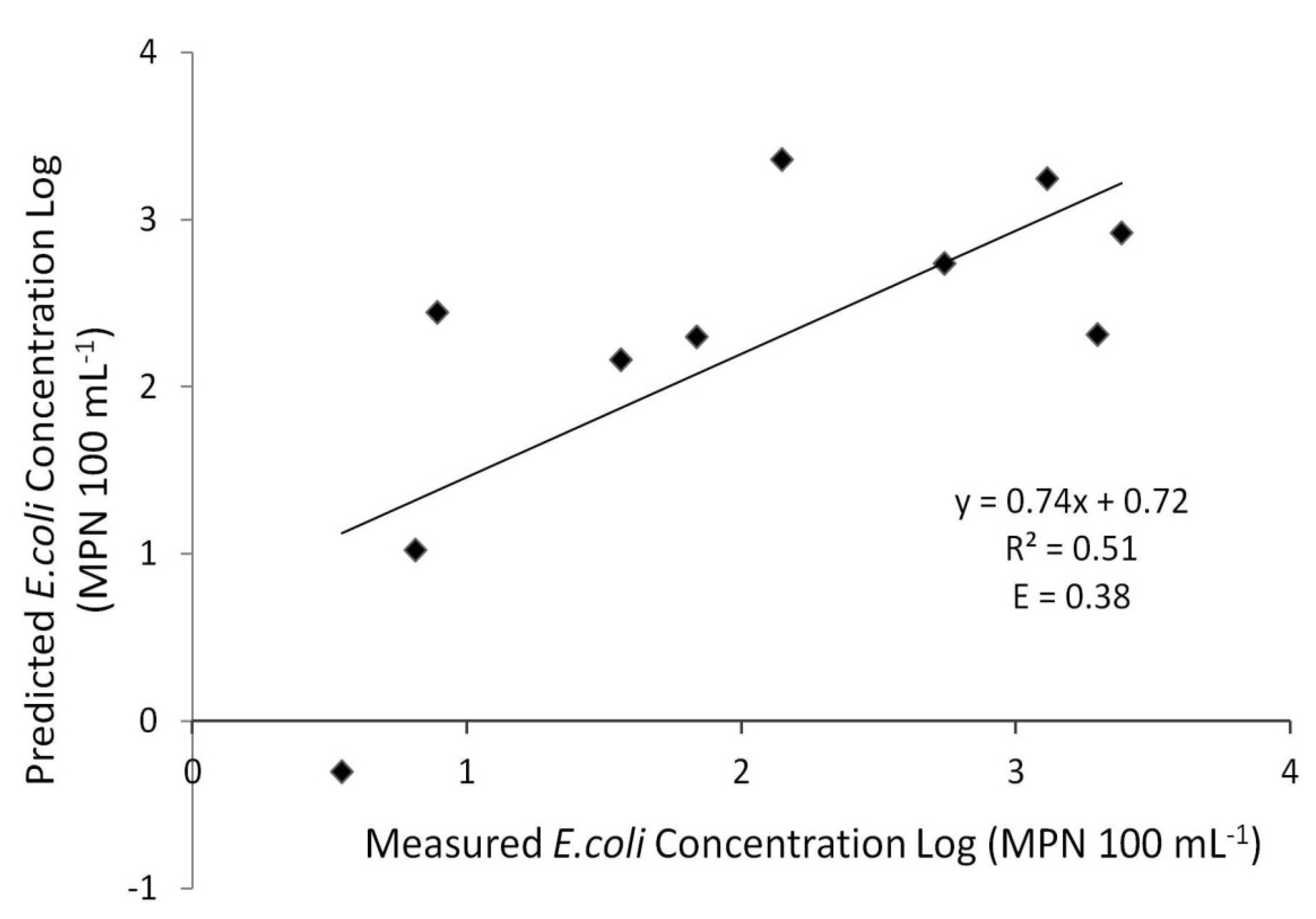

3.3.1. Sample Size
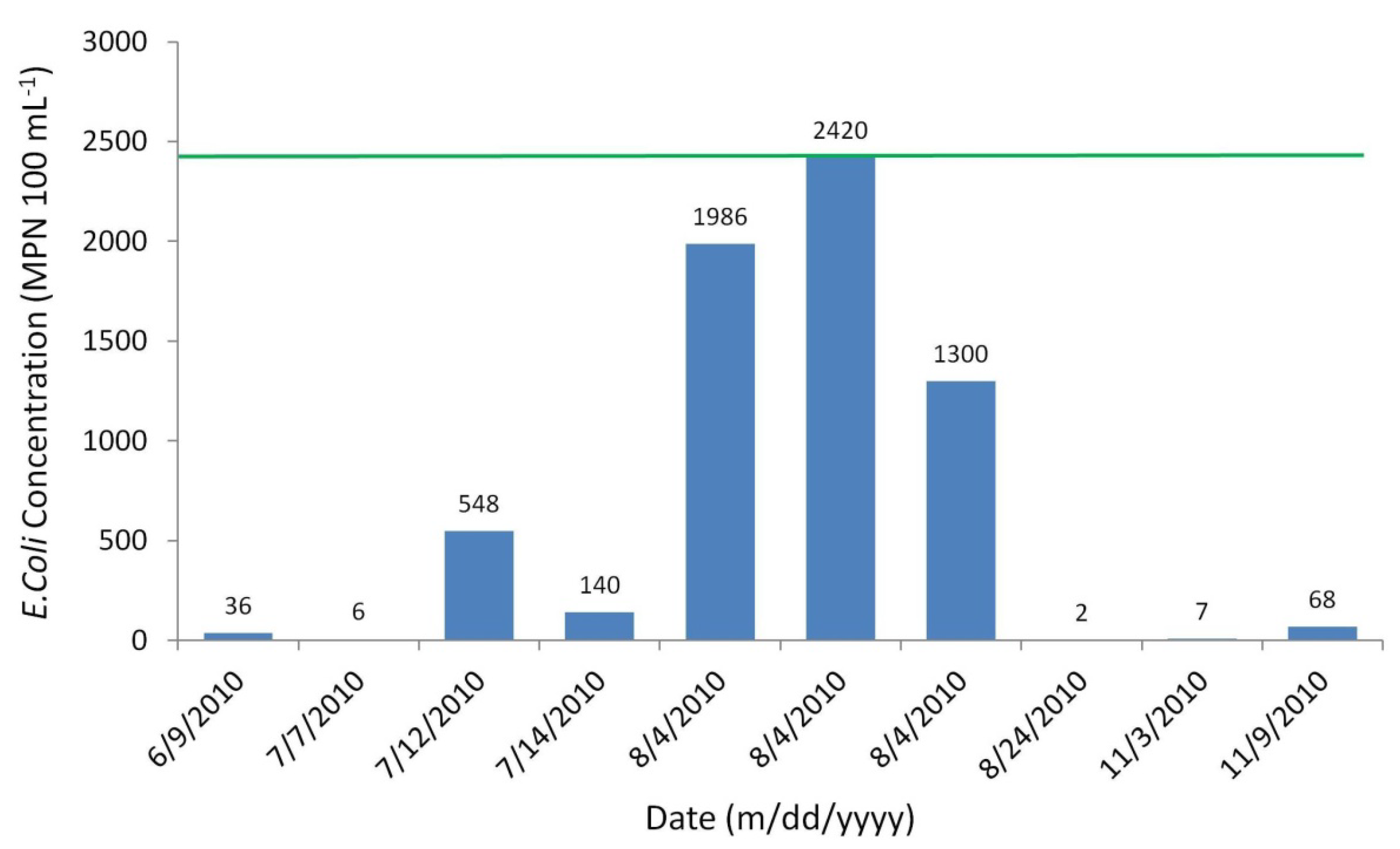

3.3.2. Seasonal Variation
3.3.3. Timing
4. Conclusions
Acknowledgments
Author Contributions
Conflicts of Interest
References
- Roberts, C.; Craig, C.; MacArthur, D.; Klaamas, P. Re-evaluation report of Nova Scotia Shellfish Growing Area NS-18-010-001—Annapolis Basin; EC Manuscript Report ST-AR-2009-04; Environment Canada: Dartmouth, Canada, 2009. [Google Scholar]
- Kamel, A.H. Application of a hydrodynamic MIKE 11 model for the Euphrates River in Iraq. Slovak J. Civ. Eng. 2008, 2, 1–7. [Google Scholar]
- Neitsch, S.L.; Arnold, J.G.; Kiniry, J.R.; Williams, J.R.; King, K.W. Soil and Water Assessment Tool Theoretical Documentation (version 2000); Grassland, Soil and Water Research Laboratory, Agricultural Research Service: Temple, TX, USA, 2002. [Google Scholar]
- Baffaut, C.; Benson, V.W. A bacteria TMDL for Shoal Creek using SWAT modelling and DNA source tracking. In Proceedings of the Total Maximum Daily Load (TMDL) Environmental Regulations–II of the Conference, Albuquerque, NM, USA, 8–12 November 2003; pp. 35–40.
- Parajuli, P.B.; Mankin, K.R.; Barnes, P.L. New methods in modelling source-specific bacteria at watershed scale using SWAT. In Proceedings of the Watershed Management to Meet Water Quality Standards and TMDLs (Total Maximum Daily Load) of the Conference, San Antonio, TX, USA, 10–14 March 2007.
- Valiela, I.; Alber, M.; LaMontagne, M. Fecal coliform loadings and stocks in Buttermilk Bay, Massachusetts, USA, and management implications. Environ. Manag. 1991, 15, 659–674. [Google Scholar] [CrossRef]
- Riou, P.; Le Saux, J.C.; Dumas, F.; Caprais, M.P.; Le Guyader, S.F.; Pommepuy, M. Microbial impact of small tributaries on water and shellfish quality in shallow coastal areas. Water Res. 2007, 41, 2774–2786. [Google Scholar] [CrossRef]
- Kelsey, R.H.; Scott, G.I.; Porter, D.E.; Siewicki, T.C.; Edwards, D.G. Improvements to shellfish harvest area closure decision making using GIS, remote sensing and predictive models. Estuaries Coasts 2010, 33, 712–722. [Google Scholar] [CrossRef]
- Bougeard, M.; Le Saux, J.C.; Pérenne, N.; Baffaut, C.; Robin, M.; Pommepuy, M. Modelling of Escherichia coli fluxes on a catchment and the impact on coastal water and shellfish quality. J. Am. Water Resour. Assoc. 2011, 47, 350–366. [Google Scholar] [CrossRef]
- Manache, G.; Melching, C.S.; Lanyon, R. Calibration of a continuous simulation fecal coliform model based on historical data analysis. J. Environ. Eng. 2007, 133, 681–691. [Google Scholar] [CrossRef]
- Liu, Z.; Hashim, N.B.; Kingery, W.L.; Huddleston, D.H. Fecal coliform modelling under two flow scenarios in St. Louis Bay of Mississippi. J. Environ. Sci. Health 2010, 45, 282–291. [Google Scholar] [CrossRef]
- Kelsey, H.; Porter, D.E.; Scott, G.; Neet, M.; White, D. Using geographic information systems and regression analysis to evaluate relationships between land use and fecal coliform bacterial pollution. J. Exp. Mar. Biol. Ecol. 2004, 298, 197–209. [Google Scholar] [CrossRef]
- Parajuli, P.B. SWAT Bacteria Sub-model Evaluation and Application. Ph.D. Thesis, Kansas State University, Manhattan, NY, USA, 2007. [Google Scholar]
- Jennings, S.; Elsaesser, B.; Baker, G.; Bree, T.; Daly, D.; Fitzpatrick, J.; Glasgow, G.; Hunter-Williams, T. An Integrated Approach to Quantifying Groundwater and Surface Water Contributions of Stream Flow; RPS Consulting Engineers Ltd.: Belfast, Northern Ireland, UK, 2000. [Google Scholar]
- Shamsudin, S.; Hashim, N. Rainfall runoff simulation using MIKE 11 NAM. J. Civ. Eng. 2002, 15, 1–13. [Google Scholar]
- Malakahmad, A.; Eisakhani, M.; Isa, M.H. Developing MIKE-11 model for water quality simulation in Bertam River, Cameron Highlands. National Energy University, Kuala Lumpur, Malaysia, 16–20 June 2008.
- Nielsen, S.A.; Hansen, E. Numerical simulation of the rainfall runoff process on a daily basis. Nord. Hydrol. 1973, 4, 171–190. [Google Scholar]
- Madsen, H. Automatic calibration of a conceptual rainfall-runoff model using multiple objectives. J. Hydrol. 2000, 235, 276–288. [Google Scholar] [CrossRef]
- Texas A&M. Texas A&M University and U.S. Bureau of Reclamation Hydrologic Modelling Inventory, Model Description Form, MIKE 11; Texas A&M University: College Station, TX, USA, 1999. [Google Scholar]
- Danish Hydraulic Institute. MIKE 11 GIS User’s Guide; DHI: Hørsholm, Denmark, 2009. [Google Scholar]
- Danish Hydraulic Institute. MIKE 11 Reference Manual; DHI: Hørsholm, Denmark, 2011. [Google Scholar]
- Neitsch, S.L.; Arnold, J.G.; Kiniry, J.R.; Williams, J.R. Soil and Water Assessment Tool Theoretical Documentation (version 2005); Grassland, Soil and Water Research Laboratory, Agricultural Research Service: Temple, TX, USA, 2005. [Google Scholar]
- Thiessen, A.H. Precipitation averages for large areas. Mon. Weather Rev. 1911, 39, 1082–1089. [Google Scholar]
- Colilert. Available online: http://www.idexx.com/view/xhtml/en_us/water/colilert.jsf?conversationId=55424 (accessed on 25 October 2010).
- U.S. Soil Conservation Society. Section 4 Hydrology. In National Engineering Handbook; U.S. Department of Agriculture, Soil Conservation Service: Washington, DC, USA, 1956. [Google Scholar]
- MapTech Inc. Fecal Coliform TMDL (Total Maximum Daily Load) Development for Upper Blackwater River, Virginia; Virginia Department of Environmental Quality and Virginia Department of Conservation and Recreation: Blacksburg, VA, USA, 2000. [Google Scholar]
- U.S. Environmental Protection Agency. nsite Wastewater Treatment System Manual; EPA-625-R-00-009; U.S. Environmental Protection Agency: Washington, DC, USA, 2002. [Google Scholar]
- Petersen, C.M.; Rifai, H.S.; Stein, R. Bacteria load estimator spreadsheet tool for modelling spatial Escherichia coli loads to an urban bayou. J. Environ. Eng. 2009, 135, 203–217. [Google Scholar] [CrossRef]
- Alderisio, K.A.; DeLuca, N. Seasonal enumeration of fecal coliform bacteria from the feces of ring-billed gulls (Larus delawarensis) and Canada geese (Branta canadensis). Appl. Environ. Microbiol. 1999, 65, 5628–5630. [Google Scholar]
- Walsh, C.J.; Kunapo, J. The importance of upland flow paths in determining urban effects on stream ecosystems. J. N. Am. Benthol. Soc. 2009, 28, 977–990. [Google Scholar] [CrossRef]
- Vinten, A.J.A.; Douglas, J.T.; Lewis, D.R.; Aitken, M.N.; Fenlon, D.R. Relative risk of surface water pollution by E. coli derived from faeces of grazing animals compared to slurry application. Soil Use Manag. 2004, 20, 13–22. [Google Scholar] [CrossRef]
- Fenlon, D.R.; Ogden, I.D.; Vinten, A.; Svoboda, I. The fate of Escherichia coli and E. coli O157 in cattle slurry after application to land. J. Appl. Microbiol. 2000, 88, 149–156. [Google Scholar] [CrossRef]
- Nash, J.E.; Sutcliffe, J.V. River flow forecasting through conceptual models part I—A discussion of principles. J. Hydrol. 1970, 10, 282–290. [Google Scholar] [CrossRef]
- Canale, R.P.; Auer, M.T.; Owens, E.M.; Heidtke, T.M.; Effler, S.W. Modelling fecal coliform bacteria–II. Model development and application. Water Res. 1993, 27, 703–714. [Google Scholar] [CrossRef]
© 2014 by the authors; licensee MDPI, Basel, Switzerland. This article is an open access article distributed under the terms and conditions of the Creative Commons Attribution license (http://creativecommons.org/licenses/by/3.0/).
Share and Cite
Butler, S.; Webster, T.; Redden, A.; Rand, J.; Crowell, N.; Livingstone, W. Using Remote Sensing to Identify Changes in Land Use and Sources of Fecal Bacteria to Support a Watershed Transport Model. Water 2014, 6, 1925-1944. https://doi.org/10.3390/w6071925
Butler S, Webster T, Redden A, Rand J, Crowell N, Livingstone W. Using Remote Sensing to Identify Changes in Land Use and Sources of Fecal Bacteria to Support a Watershed Transport Model. Water. 2014; 6(7):1925-1944. https://doi.org/10.3390/w6071925
Chicago/Turabian StyleButler, Sean, Tim Webster, Anna Redden, Jennie Rand, Nathan Crowell, and William Livingstone. 2014. "Using Remote Sensing to Identify Changes in Land Use and Sources of Fecal Bacteria to Support a Watershed Transport Model" Water 6, no. 7: 1925-1944. https://doi.org/10.3390/w6071925
APA StyleButler, S., Webster, T., Redden, A., Rand, J., Crowell, N., & Livingstone, W. (2014). Using Remote Sensing to Identify Changes in Land Use and Sources of Fecal Bacteria to Support a Watershed Transport Model. Water, 6(7), 1925-1944. https://doi.org/10.3390/w6071925




